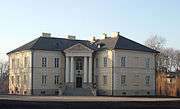Dobrzyca
Dobrzyca [dɔˈbʐɨt͡sa] is a town in Pleszew County, Greater Poland Voivodeship, in west-central Poland. It is the seat of the gmina (administrative district) called Gmina Dobrzyca.[1] It lies approximately 13 kilometres (8 mi) west of Pleszew, 15 kilometres (9 mi) northeast of Jarocin, 25 kilometres (16 mi) from Krotoszyn, and 76 km (47 mi) south-east of the regional capital Poznań. The town has a population of 3,250.
Dobrzyca | |
|---|---|
Town | |
.jpg) The museum, palace and park complex | |
 Flag  Coat of arms | |
 Dobrzyca | |
| Coordinates: 51°51′54″N 17°36′7″E | |
| Country | |
| Voivodeship | Greater Poland |
| County | Pleszew |
| Gmina | Dobrzyca |
| Elevation | 132 m (433 ft) |
| Population | 3,250 |
| Website | www.ugdobrzyca.pl |
History
The first written mention of Dobrzyca dates to 1327, when the noble Mikołaj Dobrzycki took possession of the city. In 1440, King Władysław III of Warna granted town privileges to the community. Dobrzyca lost this status only in 1934. Is again a town from 1 January 2014.
The small city had, in the 18th century, no more than 1,000 inhabitants. In the 17th century, Dobrzyca was destroyed by Swedish troops. In 1655, Hetman Jerzy Sebastian Lubomirski led an aristocratic rebellion against King Johann II, using Dobrzyca as a staging area. The rebels had a victory over the royal troops at Częstochowa, but later they withdrew to the Polish hinterland.
In 1717, wealthy landed aristocrat Alexander Gorzeński acquired the city. His grandchild was General Augustyn Gorzeński, aide to King Stanislaus II August Poniatowski, Sejm (Polish parliament) delegate and participant in the development of the Constitution of May 3, 1791, which provided stimulation to the urban economy in 1772.
Due to political changes in Poland, Dobrzyca came under Prussian rule in 1793. Over the next century, there were several rulers and in 1890, the bibliophile Count Zygmunt Czarnecki took over. The city remained the family estate of the Czarnecki family until 1939. The counts connected the city to the railway, increased agriculture and created an agricultural bank. The return to the newly re-formed country of Poland in 1918 brought the establishment of further cooperatives and associations. Stanisław Mikołajczyk, Sejm delegate and later prime minister of the Polish government-in-exile while it was headquartered in London, was baptised in the town.
After the German Reich occupation during the Second World War, housing cooperatives developed allowing the palace, which had become the town hall, to be converted into a museum. From 1975 to the present, with the regional reorganization in Poland, Dobrzyca belongs to the Voivodeship Kalisz.
Sites of interest
The Gorzeński Lock and the park are tourist destinations in Dobrzyca. Similar lock designs are in numerous in other places in Poland such as Masowien and Gołuchów, 20 km east of Dobrzyca, and another at Śmiełów to the north, where a lock was built by the same aristocratic family.
Palace
The palace of Augustyn Gorzeński, designed by Stanisław Zawadzki, was built between 1795 and 1799. It is early classical architecture, which exhibits some late Baroque style characteristics inside. Externally, it combines traditional structural elements of a Polish aristocratic seat with double wings and Freemason symbolism.
In 1940 to 1941, after the evacuation of the countess Czarnecka and her daughters, the palace was used as a grain storehouse, which contributed to the destruction of the parquet floors. In the postwar years the building served as a primary school. In 1988 it was given over to the National Museum; in 1990 it was restored under a public-private partnership.
Landscape garden
The landscaped park is noteworthy; it was developed at the beginning of the 19th century in the English style. It covers two river courses as well as several ponds and channels. The pavilion represents the Roman Pantheon. On an artificial island, there is a summerhouse and exotic plants, and a monopteros rises from one of the ponds.
.jpg) Pantheon in the Park.
Pantheon in the Park. Monopteros in the Park.
Monopteros in the Park. The Gorzeński Palace, now a museum, in Dobrzyca.
The Gorzeński Palace, now a museum, in Dobrzyca.
References
External links
| Wikimedia Commons has media related to Dobrzyca. |
| Wikimedia Commons has media related to Pałac w Dobrzycy. |